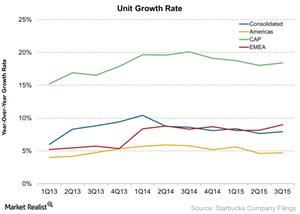Why the CAP Segment Is the Next Big Market for Starbucks
Starbucks has about 5,239 restaurants in the CAP segment. It’s growing units at an average of 18.4% compared to the rest of the regions.
Nov. 9 2015, Updated 6:04 p.m. ET

Unit growth
Previously, we discussed same-store sales growth. It’s one of the important drivers for restaurant companies like Starbucks (SBUX), Darden Restaurants (DRI), McDonald’s (MCD), and Yum! Brands (YUM). Unit growth is another key revenue driver. A restaurant company must be careful not to grow units too quickly, otherwise it will become an operational risk. It could cause the company to close locations.
Segment growth rate
- Overall, across all of its segments—the Americas, CAP (China/Asia-Pacific), and EMEA (Europe, the Middle East and Africa)—Starbucks added units at the rate of 8% over the past 11 quarters.
- Of the 22,500 restaurants in the system, Starbucks has about 14,570 locations in the Americas region. It added units at an average rate of 5% over the past 11 quarters.
- Starbucks has about 5,239 restaurants in the CAP segment. It’s growing units at a much faster rate at an average of 18.4% compared to the rest of the regions.
- This explains why the CAP segment is the next big market for Starbucks.
- With the acquisition of locations in the Japan segment, Starbucks showed how serious it’s taking the CAP segment.
- The question remains whether Starbucks will continue to grow the units in the CAP segment, especially in China, at the same rate when the economy is showing signs of weakness.
- The company added restaurants at an average of 7% over the past 11 quarters in the EMEA segment. Currently, it has 2,291 restaurants.
Starbucks forms about 2.3% of the iShares Global Consumer Discretionary (RXI).
Next, we’ll discuss Starbucks’ operating margins and what to expect in the upcoming earnings.
